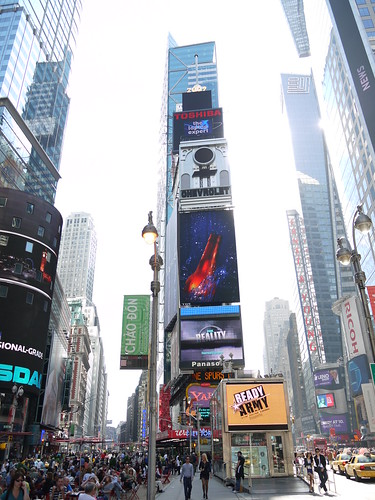by Stephen T. Del Percio
On March 28, 2000, one hundred commercial office buildings throughout the United States received an Energy Star Label, "the federal government's highest symbol of excellence for energy efficiency and environmental conservation.To qualify for Star status, which certifies buildings in the top quarter of comparable buildings in terms of energy efficiency, a building must meet certain energy performance criteria; it must also satisfy minimum standards for healthy indoor air quality. The Environmental Protection Agency (EPA) and the United States Department of Energy (USDOE) created the designation in 1998 "as an incentive for the [real estate] industry to reduce demand for electrical energy use and, thereby, help lower greenhouse gas emissions.
Four Times Square, a forty-eight story post modem office tower in the heart of Manhattan's Times Square, was one of the recipients of an Energy Star Label. The Durst Organization, its developer, chose a site that at the time seemed highly incongruous to the stringent, globally conscious, environmental construction standards it required of the entire project team. Completed in 1998, the building was America's first environment-friendly, large-scale green construction project, and it quickly became an important focal point of the ongoing controversy over the purported benefits of sustainable design. Notably, the tower's success as America's first green high-rise indirectly led to the creation of the United States Green Building Council's (USGBC) Leadership in Energy and Environmental Design (LEED) Green Building Rating System for high performance buildings.8 The critical acclaim that the building's innovative sustainable design concepts received, in both architectural and academic circles, encouraged developers across the street at Three Times Square to adopt similar green standards for their new high-rise office building. Boston Properties, the developer of the final two office towers in the Times Square redevelopment scheme, chose not to incorporate green elements into either of its structures despite the acclaim Four Times Square had received.
The overwhelming lack of uniform green design elements in America's most important modem high-rise buildings, in spite of substantial guidance for developers and contractors provided through programs like LEED," has led some to suggest that the purported economic and environmental benefits of such construction are illusory. This suggestion is erroneous. The necessity for green design in responsible twenty-first century architecture becomes frighteningly clear upon an examination of the impact high-rise construction has on the natural environment; the construction, maintenance, and operation of residential and commercial buildings in the United States produces numerous negative externalities which wreak havoc on the natural ecosystems in which those structures are erected. Moreover, many universally accepted global environmental problems have been directly or indirectly associated with the
built environment. Buildings occupy significant amounts of land, modify natural hydrologic cycles, contribute to global climate change, affect biodiversity, contribute to soil erosion, have major impacts on water and air quality, and are sources of major quantities of solid waste. It follows that promoting green buildings is essential to the ecological future of both our country and our planet.
Four Times Square, a forty-eight story post modem office tower in the heart of Manhattan's Times Square, was one of the recipients of an Energy Star Label. The Durst Organization, its developer, chose a site that at the time seemed highly incongruous to the stringent, globally conscious, environmental construction standards it required of the entire project team. Completed in 1998, the building was America's first environment-friendly, large-scale green construction project, and it quickly became an important focal point of the ongoing controversy over the purported benefits of sustainable design. Notably, the tower's success as America's first green high-rise indirectly led to the creation of the United States Green Building Council's (USGBC) Leadership in Energy and Environmental Design (LEED) Green Building Rating System for high performance buildings.8 The critical acclaim that the building's innovative sustainable design concepts received, in both architectural and academic circles, encouraged developers across the street at Three Times Square to adopt similar green standards for their new high-rise office building. Boston Properties, the developer of the final two office towers in the Times Square redevelopment scheme, chose not to incorporate green elements into either of its structures despite the acclaim Four Times Square had received.
The overwhelming lack of uniform green design elements in America's most important modem high-rise buildings, in spite of substantial guidance for developers and contractors provided through programs like LEED," has led some to suggest that the purported economic and environmental benefits of such construction are illusory. This suggestion is erroneous. The necessity for green design in responsible twenty-first century architecture becomes frighteningly clear upon an examination of the impact high-rise construction has on the natural environment; the construction, maintenance, and operation of residential and commercial buildings in the United States produces numerous negative externalities which wreak havoc on the natural ecosystems in which those structures are erected. Moreover, many universally accepted global environmental problems have been directly or indirectly associated with the
built environment. Buildings occupy significant amounts of land, modify natural hydrologic cycles, contribute to global climate change, affect biodiversity, contribute to soil erosion, have major impacts on water and air quality, and are sources of major quantities of solid waste. It follows that promoting green buildings is essential to the ecological future of both our country and our planet.

more about architecture:
This is a really good announcement for the country, but I believe its not enough. 100 is nothing, we need to be stretching out and encouraging homes and businesses, the rich and the middle class, to go green. We need to save our resources before their all gone!
ReplyDelete-Sharone Tal